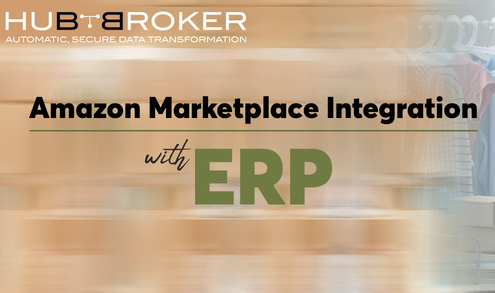How to Exchange Order & Inventory Data Between ERP & Amazon Marketplace
Amazon has emerged as an undisputed leader among all the online e-commerce platforms available in today’s market. With over 300 million active customer accounts worldwide, Amazon is something that most sellers and retailers cannot afford to ignore.
Having your products on Amazon allows you to profit from new selling opportunities and expose your product to a new buyer audience. A recent study from Feedvisor found out that almost 89% of consumers are more likely to buy products from Amazon than any other e-commerce site. To further establish Amazon’s importance as a critical e-commerce channel for every seller, another study found that one-third of all sellers on Amazon have an average mark-up between 25% and 50%!
Moreover, this platform has acted as the door for most sellers to step into the realms of Multi-channel retailing. According to a survey, 77% of third-party sellers on Amazon sell through multiple channels, including online marketplaces, web stores, and brick-and-mortar stores.
More Money, More Problems
Though Amazon sounds like a stellar and pretty straightforward selling opportunity for most sellers, with the increased order numbers, most of them face trouble in timely order processing and inventory management.
The most significant reason for this trouble is the manual transfer of order, customer & inventory data from Amazon seller central or vendor central account to the seller’s in-house ERP system. Moreover, the manual rekeying of such critical business data also increases the chances of costly data errors that can have a lasting impact on the business.
Companies are looking for EDI solutions like amazon integration API, amazon EDI integration, amazon ERP integration, etc. to make everything digital and simple.
Benefits of integrating your Amazon store with your ERP system
- Integrating your Amazon store with an ERP system offers a plethora of benefits to your business. This investment streamlines your organization and encourages you to make agile business decisions. These days, businesses are not only dependent on one sales channel. Now, companies are adopting a multi-channel selling approach through their own ecommerce store, on online marketplaces and retail outlets.
- Integrating your Amazon store alleviates the risk associated with manual data entry like duplicate entry.
- By extirpating the time-consuming and strenuous manual data entry process, Hubbroker’s amazon EDI integration platform enhances the speed of information exchange. This improves your customer service efficiency and customer satisfaction.
- Earlier, data needed to enter manually into your ERP from Amazon. This leads to a lot of errors for your business. Now, data passes through a validation layer, this minimizes costly errors and chargebacks.
- Integrating your Amazon store and ERP creates an efficient workflow between departments and functionalities in your organization. An integrated flow of data will give you an insight that helps you to make strong decisions for the betterment of your business.
ERP with Amazon:: A Profitable Unison
An ERP system acts as an ideal business management platform that provides a 360° view of the entire operation and easy management of day-to-day business processes. Integrating your Amazon seller central account with your ERP system allows you to manage all the critical business data such as orders, order confirmations, delivery notes, invoices, master data of your customers, and inventory from one place.
With all the data from Amazon synchronized with the ERP system in real-time, you save considerable time & resources by avoiding manual work and also gain the ability to automate essential processes such as the flow of order.
Some of the vital automation that can be achieved by integrating Amazon with your ERP system includes:
- Automatic renewal of inventory and prices
- Importing orders from Amazon to the in-house ERP or accounting system
- Exporting order acknowledgments, dispatch notes to Amazon
- Exporting customer invoices to Amazon
- Exporting various Amazon Seller reports
Automating the flow of order and inventory data between Amazon and ERP system enables you to create standardized workflows, ensuring faster processing of orders while maintaining the required inventory levels at all times.
Having all the information about marketplace activities on your ERP system enables you to derive critical insight into the sales cycle of your products, customer behavior, and much more. This invaluable information aids in critical decision making, streamlining the sales cycle, and maximizing your sales potential.
How to Integrate Amazon with your ERP System?
Majority of the popular ERP systems cannot be readily integrated with Amazon seller & vendor central, but that’s where APIs come in.
API stands for an application programming interface. This software technology allows multiple applications to interact and obtain data from one another in real-time.
So, using an API integration app, your ERP system can obtain and transmit information to and from Amazon seller central account. Additionally, such APIs can also be used to connect your other marketplace accounts and sales channels with the ERP or accounting systems.
The data that can be retrieved from Amazon marketplace using API includes:
- Product catalog
- Inventory
- Orders data
- Management for Seller Central
- Advertising data for both Vendor Central and Seller Central
- Purchase order management for Vendor Central
- Affiliate promotion info
- Other data points needed to manage the Amazon channel
HubBroker provides API integration solutions that facilitate information exchange between the Amazon marketplace and ERP or accounting system. HubBroker can receive and deliver data in nearly all possible formats and from all existing channels, hence can swiftly adapt to the capabilities of your ERP and accounting system.
[/et_pb_text][/et_pb_column][/et_pb_row][/et_pb_section]




